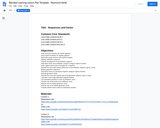
Students examine sequences and are introduced to the notation used to describe them.
- Subject:
- Math 1
- Mathematics
- Material Type:
- Lesson
- Author:
- EngageNY
- Date Added:
- 02/03/2020

Students examine sequences and are introduced to the notation used to describe them.

Students write sequences with recursive and explicit formulas.

Lesson plans and activities which address the concept of arithmetic sequences, finishes arithmetic sequences and applies the idea of arithmetic sequences.

Solve a series of arithmetic sequences in this Millionaire Maker game.

Solve a series of arithmetic sequences in this Millionaire Maker game.

Students learn the structure of arithmetic and geometric sequences.

This task builds upon students’ experiences with arithmetic and geometric sequences to
extend to the broader class of linear and exponential functions with continuous domains. The term
“domain” should be introduced and used throughout the whole group discussion. Students are
given contextual situations that can be modeled with either discrete and continuous linear
functions, or discrete and continuous exponential functions. They are also asked to compare these
types of functions using various representations.

In this Khan Academy activity, students will find the next term in an arithmetic sequence.

In this Khan Academy activity, students will find the next term in a geometric sequence.

In this Khan Academy activity, students will find the next term in a geometric sequence.

Students will compare patterns of arithmetic and geometric sequences, and then use the geometric sequence formula to solve practice problems.

Students will use a video about two rival competitive eaters to explore linear and quadratic patterns.

This lesson is designed to introduce students to the arithmetic and geometric sequences.

This task provides opportunities for students to show their understanding of functions in various representations by making matches (3 cards in a set).

This is an Algebra 2 Unit that explores sequences and series. This includes arithmetic, geometric, and other sequences, as well as recursive and explicit formulas that generate these sequences. Arithmetic, finite geometric, and infinite geometric series are also covered in this unit. This unit is designed as a flipped instructional unit. Worksheets and video links are provided.

The purpose of this task is for students to explicitly consider when a discrete or continuous model
is appropriate for a given context. The situations in this task are designed to contrast discrete and
continuous models for both linear and exponential functions. The task also provides opportunity
for students to model with mathematics by connecting the type of change, either linear or
exponential with the nature of that change, either discrete or continuous.

This task is designed for students to practice their understanding of function. After reviewing various naming conventions of function (“versus”, “with respect to”, “over”, “dependent on”), students are to determine whether or not each situation is a function, then justify their answer.

In this Khan Academy activity, students will find the nth term in an arithmetic sequence.

In this Khan Academy activity, students will find the nth term in a geometric sequence.